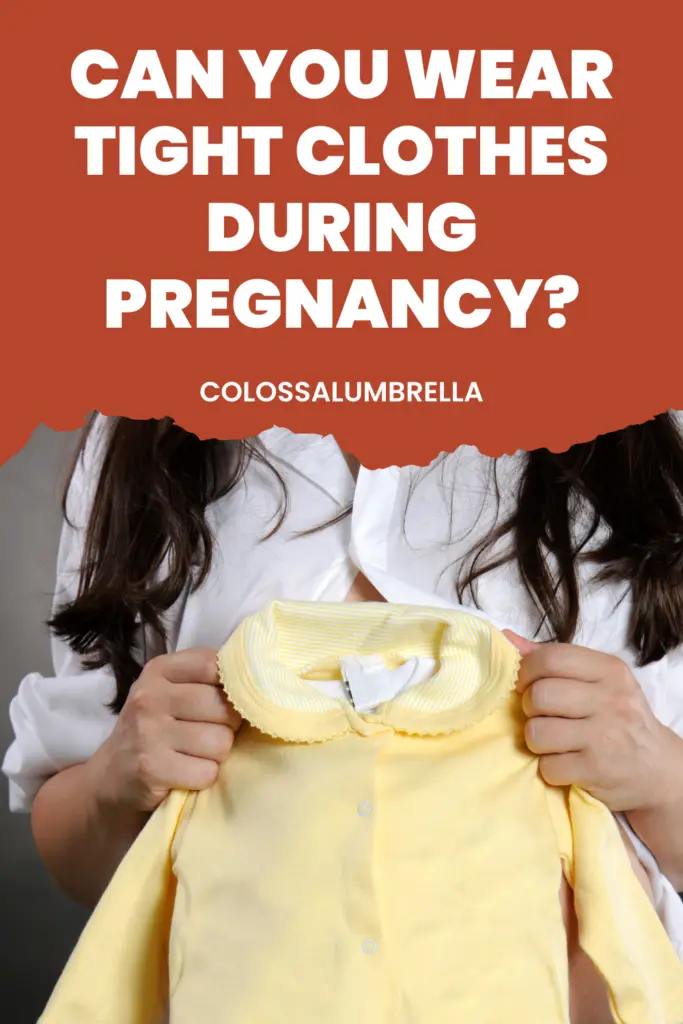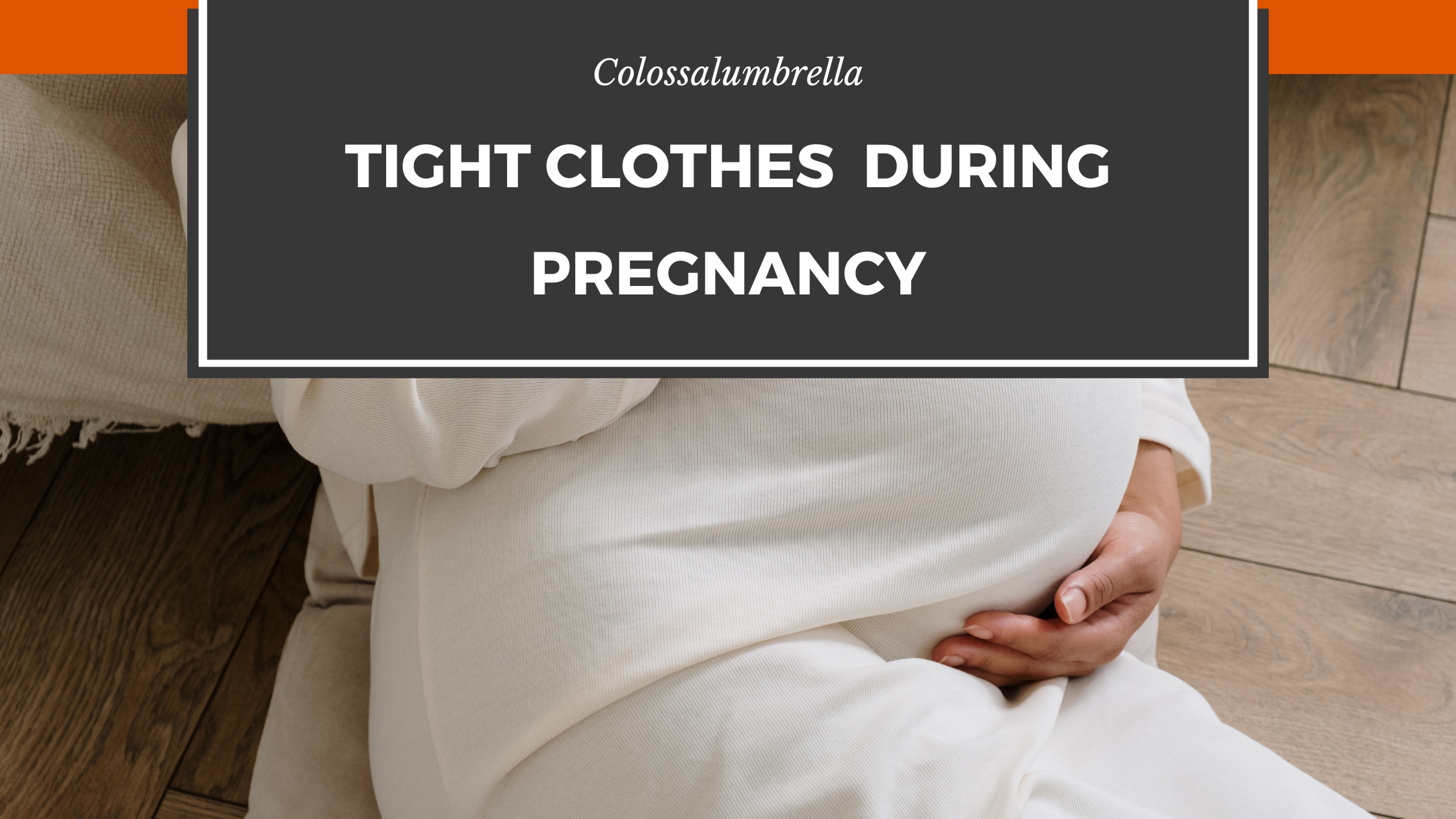Contents
You wake up one morning, and suddenly, your favorite jeans are giving you the side-eye. “Hey there, mom-to-be! Mind giving us a little breathing room?” they say. And you’re like, “Wait, did my pants just talk to me?!”
Pregnancy is a rollercoaster of excitement and wonder, and your wardrobe gets a front-row seat. Suddenly, you find yourself wondering, “What the heck do I wear now that I’ve got a little one on board?! As the belly grows to accommodate the precious life within, comfort becomes an utmost priority for expectant mothers. In this blog post, I will discuss the impact of wearing tight pants around waist during pregnancy, exploring the potential risks they pose to both the mother and the developing baby. I’ll also provide valuable insights into choosing the right maternity wear that strikes the perfect balance between comfort and style.
Tight pants around waist during pregnancy?
During pregnancy, your body undergoes significant changes to accommodate the growing baby. Wearing tight pants can create unnecessary pressure on your abdomen and uterus, leading to discomfort and even potential health risks. Additionally, these constrictive garments can restrict blood circulation, causing swelling and edema in the legs and feet. As your baby bump grows, tight waistbands can exacerbate bloating and digestive issues, leaving you feeling uneasy and distressed. Furthermore, nerve compression resulting from tight clothing can lead to tingling sensations or numbness in various areas.
What is Miscarriage?
A miscarriage is the spontaneous loss of a pregnancy before the 20th week, usually occurring due to genetic or hormonal issues, infections, or other health issues in the mother. While it’s a common concern, it’s important to understand that miscarriage is a complex issue, and clothing choices alone are unlikely to be the sole cause.
Common Causes of Miscarriage
- Chromosomal abnormalities: If the fetus has abnormal chromosomes, it may not develop properly in the womb, leading to a miscarriage.
- Infections or exposure to toxins: Infections, particularly those caused by bacteria or viruses, can cause miscarriage. Exposure to harmful substances like lead, mercury, or radiation can also increase the risk.
- Maternal age: Women over 35 have an increased risk of miscarriage, as their eggs may not be as healthy as those of younger women.
- Physical conditions in the mother: Certain conditions or illnesses, such as autoimmune diseases, STDs, thyroid disease, diabetes, and kidney or heart disease, can increase the risk for miscarriage.
- Drug and alcohol use: Substance use during pregnancy is a known risk factor for miscarriage. Regular use of cigarettes, alcohol, and drugs can cause serious health consequences for both the mother and baby, including miscarriage.
- Environmental factors: Exposure to radiation, hazardous materials, and high levels of stress can increase the risk of miscarriage in early pregnancy.
The Importance of Comfortable Clothing during pregnancy
Wearing tight clothes during pregnancy may cause discomfort and circulation issues for the expecting mother. Tight clothing can interfere with the normal flow of blood in the body, affecting the growth and development of the baby. Additionally, tight pants can make it more difficult to recognize changes in the baby’s size and shape, which are essential to monitor during pregnancy.
It’s crucial to prioritize comfort during pregnancy by wearing loose-fitting, breathable clothing. Maternity clothing is an excellent option, as it is designed to accommodate a growing baby bump.
Recognizing the Signs of Tight Clothing
Be mindful of the signs indicating that tight clothes during pregnancy. If you notice red marks or indentations around your waist after removing the pants, it’s a clear sign of undue pressure on your skin. Discomfort and soreness, especially after extended wear, are also common indicators. Swelling and edema in the lower extremities may arise due to impaired blood flow caused by tight clothing. Additionally, if you experience numbness or tingling sensations in your legs, it’s time to reassess your pants’ fit.
When to Switch to Loose Clothing
There is no specific timeline for when you should switch to loose clothing during pregnancy, as each woman’s body is unique and changes differently. However, it’s essential to start wearing loose clothing as soon as it becomes uncomfortable. Some women begin wearing loose clothing as early as the first trimester, while others may wait until the second or third trimester.
First Trimester
During the first trimester, the baby is still relatively small, and most women don’t experience a significant change in their body size. However, some women may find that their pants become tighter around the waist, even if they haven’t gained much weight. If you’re experiencing discomfort due to tight pants in the first trimester, it’s a good idea to switch to looser clothing options.
Second Trimester
Many women begin to notice significant changes in their body size during the second trimester. As the baby grows, the uterus expands and places increased pressure on the abdomen, making it essential to wear comfortable clothing. If you haven’t already switched to loose clothing, the second trimester is an excellent time to do so.
Third Trimester
By the third trimester, most women experience significant changes in their body size and shape, making it essential to wear loose, comfortable clothing. Tight pants can cause discomfort and restrict blood flow, potentially affecting the baby’s growth and development.
Tips for Choosing Comfortable Clothing During Pregnancy
- Opt for maternity clothing: Maternity clothing is specifically designed to accommodate a growing baby bump and provide comfort and support for expecting mothers. Maternity jeans and leggings with adjustable waistbands are great options for pregnant women.
- Choose breathable, stretchy fabrics: Look for clothing made from breathable materials like cotton, as they allow for more airflow and stretch easily to accommodate your changing body. Avoid synthetic and wool fabrics, as they can cause chafing and discomfort.
- Avoid high heels and flat shoes: High heels can increase the risk of falls and slipped discs, while flat, hard-soled shoes may not provide adequate support. Opt for comfortable, supportive footwear during pregnancy.
- Accessorises: Use accessories and splashes of color to lift your mood, make you look and feel beautiful, and add variety to your wardrobe.
Staying Active and Fit During Pregnancy
Maintaining regular exercise during pregnancy is essential for your health and well-being. Comfortable activewear that accommodates your growing belly is crucial for a successful workout session. Consider investing in maternity-specific activewear designed to provide support and flexibility. Yoga, in particular, offers various benefits during pregnancy, including improved flexibility, reduced stress, and enhanced breathing techniques. Don’t compromise on comfort while staying active; your body and baby will thank you.
Tips for Easing Discomfort While Wearing tight clothes during pregnancy
If you find yourself in a situation where you have to wear pants but want to remain comfortable, there are several tricks to ease the discomfort. Consider using a belly band or maternity support belt to provide extra support to your belly and alleviate pressure on your waist. Unbuttoning or extending the waistband slightly can offer some relief without compromising the fit too much. When shopping for pants, prioritize those made from stretchable fabric that can adapt to your changing body shape. Finally, remember to take short breaks and find comfortable positions to reduce the strain on your abdomen.

People Also Ask
Can a tight waistband harm my baby?
A tight waistband can potentially harm your unborn baby by placing extra pressure on the abdomen, compromising the baby’s blood flow and causing decreased oxygen and nutrient transfer. Additionally, a tight waistband can cause decreased fetal movement, which is essential for the baby’s well-being.
What week of pregnancy do clothes get tight?
Clothes may start to get tight during the second trimester (weeks 13-27), as many women notice changes in their body size. However, this can vary greatly depending on factors like height, body shape, the number of babies being carried, and the size of the baby.
Can you wear jeans while 5 weeks pregnant?
Yes, you can wear jeans while 5 weeks pregnant, as long as they are comfortable and not too tight. Jeans made from breathable fabric with adjustable waistbands are ideal for pregnant women.
Conclusion
The primary concern, “wearing tight pants around waist during pregnancy” is generally unfounded. While tight pants around the waist during pregnancy may cause discomfort and circulation issues, there is no direct link to miscarriage. However, it’s essential to prioritize comfort and wear loose, breathable clothing throughout your pregnancy to ensure your well-being and that of your unborn child. Remember to consult with your healthcare provider for personalized advice and guidance during your pregnancy journey.
Wearing tight pants around waist during pregnancy
Disclaimer: The content of this blog is for informational purposes only and is not intended to be a substitute for professional medical advice, diagnosis, or treatment. Always seek the advice of your physician or other qualified healthcare providers with any questions you may have regarding a medical condition.
I would stay connected and keep you updated with parenting tips, pregnancy guides, creative ideas, easy crafts, and Free Printables. Subscribe to Colossalumbrella to get new ideas delivered to your inbox. Follow me on Facebook, Pinterest, Twitter, and Instagram.
